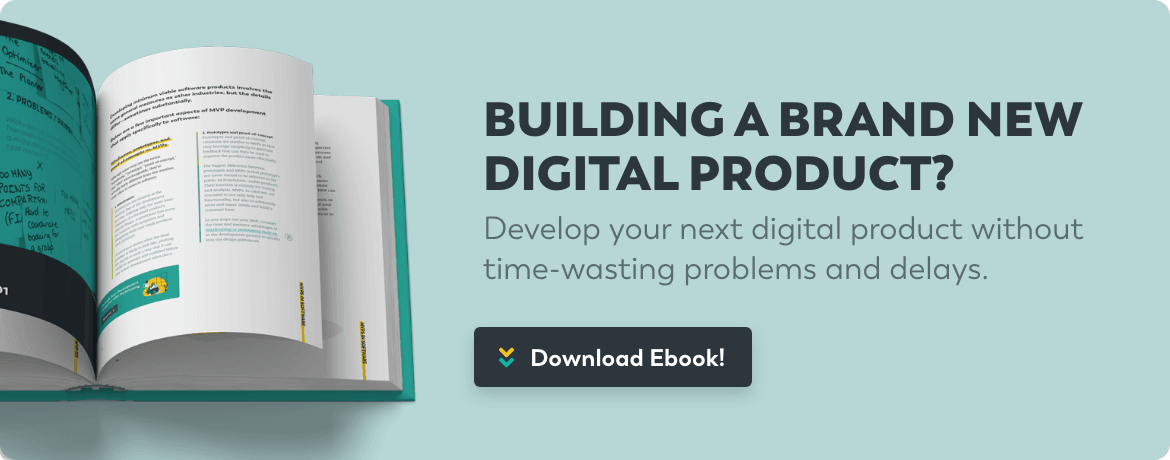Building a Minimum Viable Product (MVP) is an exciting time for your business. But starting with the right mindset is key to developing a successful MVP. It takes a clear vision, extensive research, good feedback, and a solid plan to launch an MVP without getting bogged down or losing sight of goals.
What is the right mindset for building a minimum viable product?
The right mindset when building an MVP is one of curiosity and learning.
In simplest terms, an MVP is a product that has just enough features to satisfy early users and validate a hypothesis.
Getting a product to market with just the features that users absolutely need is important from a business standpoint. It helps you streamline costs by reducing superfluous features and gives potential investors something to put their faith in.
But your MVP isn’t just about getting a product to market. It’s about building an experiment to help you develop that product to meet the needs of your users by learning what those users want. That’s because those users can give you quality feedback on the features that are and aren’t in the product. You can get real data on how the product is used before you even think about building more features into it.
So, if you approach building an MVP from a place of learning, you’ll build a more customer-focused product and mindset that better serves your users. In turn, you’ll have a more stable product and user base that you can build on for years. Finally, you’ll also build an intimate relationship with that user base that shows that you want to meet them where they are.
3 steps to the right mindset
1. Understand what you want to build
A solid product starts with your vision for solving a problem. If you can’t clearly idealize the kind of platform or product you want to put in front of your users, you’ll just end up with a confused set of features.
Ask yourselves these questions:
- What need do I think I’m meeting for these users?
- What are the features that I think my users are looking for to meet those needs?
- Where does it fit in the market?
- What technology am I using to build this product?
- What kind of access or support do I want to provide?
All of these questions are based on solving the problem you’ve identified and validated. Once you’ve answered these questions, make them clear. That could be through wireframes, diagrams, UX design, whatever you have at your disposal. An MVP can’t have a confused development or it will be confusing for users.
Once you know what you want to build on a basic level, you need to gather input from customers to refine your vision.
## 2. Learn what customers want
An MVP can do a lot of things for your company. But, one of the most important things it’s going to accomplish for your team is helping you gather knowledge. Building an MVP is like a diagnostic for your idea: by putting out something that you think that customers want, you can find out more about what they need.
You aren’t going to get quality information, however, if you don’t have a clue about what you think they want in the first place. This is the point where you get into detective mode, researching clues not just about product viability but also about how you can gather data about customer behaviors and responses to continue building out your product. If you aren’t already targeting what you think users need, you won’t be able to get the insight you need to nurture the product.
3. Think of the MVP as a strategy, not a product
This might seem counterintuitive, but move away from the paradigm that your MVP is a product. Think of it instead as a means to build and refine a strategy.
So you’re building the product, but what are you doing with it? What kind of data collection do you want to do? Who do you want to use it, and for how long?
These questions are critical to the learning process for your MVP. Focus on where you can get the best insight for your platform or product. If you want to serve database administrators, you might find different DBA communities across multiple different platforms. Likewise, if you are fielding a global product, you’ll want to gear your initial product towards developers on global technologies.
Thinking strategically will ensure that your MVP isn’t the end of the road, but a starting point for your business.
The MVP is not your final product
If you want to learn from your MVP, you need to view it as part of the process of discovery as you build your product. Sure, you are technically releasing that product to users with the MVP, but it will change as you learn more down the line.
So ensure that your vision is clear, you’ve looked to the needs of your users, and that you’ve built your product around a sound strategy of learning, to build a product that people need. If you stay in this mindset, you’ll be on your way to providing a product that will be indispensable to your users.
Our agile development team builds MVPs for startups as part of a process aimed at growing businesses. Set up a call to find out more.
